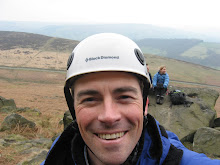
Looking to be guided on trekking and snowshoeing terrain, either in the UK or internationally, then you require a group leader who has been highly trained and assessed in mountain navigation, first aid, emergency ropework, group management, altitude sickness, training and physiology. You will find all these attributes in a qualified International Mountain Leader (IML).
It is your guarantee of the highest possible standards and experience.
Who regulates and trains the IMLs?
All IMLs hold the carnet and wear the badges of the Union of International Mountain Leader Associations (UIMLA), and they follow their standards and code of practice. The IML is also affiliated to their home nation association. In the British association (BAIML) there are over 300 fully qualified IMLs, who have experience from the Arctic to the Andes. The national association keeps a register of members, and like all professional bodies it expects its members to be undertaking continuous professional development.
In the UK the IML award is administered by Mountain Leader Training UK, and is valid when the IML is a member of a national association and if they hold professional indemnity insurance. The IML award is a professional qualification, recognised since 1993 by the former Commission Européenne des Accompagnateurs en Montagne (CEAM), and since November 2004 by UIMLA. You can rest assured that an IML is a highly trained professional.
Where can IMLs lead?
You should think of an IML as a trekking and snowshoeing guide who can lead in mountainous
terrain all over the world. No climbing as such is involved, but the IML will be very competent
in rope work, to look after you on steep terrain if necessary. No glacier travel is involved, as that
terrain is led by the International Mountain Guides, but an IML can lead groups on snowy treks
that do not require the use of crampons. In many cases these types of routes are guided on snowshoes, and many IMLs are highly experienced in their use, as well as in snow safety and avalanche awareness. The scope of where an IML can lead you is vast, and you will see them all around the world’s mountains from Everest base camp to the Tour du Mont Blanc trek, and from Kilimanjaro to snowshoeing in the Rockies.
What should I expect to learn from an IML?
Apart from navigating and looking after your safety, the key role of an IML is an educational one, and they will aim to impart a lot of information about the region you are visiting in terms of geology, history, culture, geomorphology and the environment. Many IMLs choose to specialise in one of these topics, which might appeal to certain clients seeking in depth knowledge on topics such as glaciology or the flora and fauna. In other words, an IML will do far more than just to lead you from A to B. They aim to enthuse and share with you their knowledge, to give you a far richer experience and understanding of the mountains.
How should I select an IML to lead you?
By now you are aware of the high level of training that an IML has received to earn their award, but just the qualification alone should not be enough for you. When selecting an IML to lead you, look for the experience they have in the region that you are visiting. All IMLs will happily provide you with details of this, and if you have a special interest such as geology, you should check that your IML has the depth of knowledge you require in this field. You can look at the British association of IMLs website (www.baiml.org) for the online directory of members, where you can search for IMLs by different criteria including regional experience.
What time of year is best?
You can travel at any time of year, but you should ask your IML for advice on when is the best season to visit your chosen location. For example, if you are trekking in the Himalayas there is a
Spring and Autumn season that avoids the monsoon rains. For an activity such as snowshoeing, in the Alps this is best enjoyed from December to April each year. Whatever time of year
you want to travel, there will be some of the world’s mountains in prime condition. Ask the IML for ideas…
Should I train for a trek led by an IML?
Your IML will be able to advise you on the length of days and the height gains and losses that are involved on each day of your trek, and they will tell you what level of fitness is required. Some day walks only require a low level of fitness, and your existing level of fitness will be absolutely fine, whilst other multi-day treks can be gruelling unless you have a very high fitness level. The IML can help devise a training regime for you, or you can consult a doctor or personal trainer for more detailed information. It is important for you to be at a suitable level of fitness for your trek, so that you can enjoy it and get the most out of your time in the mountains. When first discussing your plans with an IML, it is essential to discuss the training requirements.
Ace-Outdoors.co.uk?
Currently we are working towards accrediting all our instructors who operate overseas with the IML award as a main leading qualification. Pete already had passed the summer assessment and will be looking to be assessed on the winter assessment in March 2010.
We hope to start offering international trekking and snow shoeing journeys starting in 2011...please visit our main website at www.ace-outdoors.co.uk to view information on hill walking and trekking.




No comments:
Post a Comment